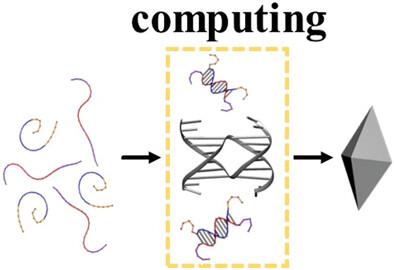当前位置:
X-MOL 学术
›
Adv. Mater.
›
论文详情
Our official English website, www.x-mol.net, welcomes your feedback! (Note: you will need to create a separate account there.)
Implementing Logic Gates by DNA Crystal Engineering
Advanced Materials ( IF 29.4 ) Pub Date : 2023-05-23 , DOI: 10.1002/adma.202302345 Cuizheng Zhang 1 , Victoria E Paluzzi 1 , Ruojie Sha 2 , Natasha Jonoska 3 , Chengde Mao 1
Advanced Materials ( IF 29.4 ) Pub Date : 2023-05-23 , DOI: 10.1002/adma.202302345 Cuizheng Zhang 1 , Victoria E Paluzzi 1 , Ruojie Sha 2 , Natasha Jonoska 3 , Chengde Mao 1
Affiliation

|
DNA self-assembly computation is attractive for its potential to perform massively parallel information processing at the molecular level while at the same time maintaining its natural biocompatibility. It has been extensively studied at the individual molecule level, but not as much as ensembles in 3D. Here, the feasibility of implementing logic gates, the basic computation operations, in large ensembles: macroscopic, engineered 3D DNA crystals is demonstrated. The building blocks are the recently developed DNA double crossover-like (DXL) motifs. They can associate with each other via sticky-end cohesion. Common logic gates are realized by encoding the inputs within the sticky ends of the motifs. The outputs are demonstrated through the formation of macroscopic crystals that can be easily observed. This study points to a new direction of construction of complex 3D crystal architectures and DNA-based biosensors with easy readouts.
中文翻译:

通过 DNA Crystal Engineering 实现逻辑门
DNA 自组装计算因其在分子水平上执行大规模并行信息处理的潜力而具有吸引力,同时保持其天然的生物相容性。它在单个分子水平上得到了广泛的研究,但还不如 3D 中的整体研究那么多。在这里,展示了在大型集合中实现逻辑门(基本计算操作)的可行性:宏观的工程 3D DNA 晶体。构建模块是最近开发的 DNA 双交叉样 (DXL) 基序。它们可以通过粘端内聚力相互关联。常见的逻辑门是通过在模体的粘性端内对输入进行编码来实现的。输出通过易于观察的宏观晶体的形成来证明。这项研究指出了构建复杂 3D 晶体结构和易于读数的基于 DNA 的生物传感器的新方向。
更新日期:2023-05-23
中文翻译:

通过 DNA Crystal Engineering 实现逻辑门
DNA 自组装计算因其在分子水平上执行大规模并行信息处理的潜力而具有吸引力,同时保持其天然的生物相容性。它在单个分子水平上得到了广泛的研究,但还不如 3D 中的整体研究那么多。在这里,展示了在大型集合中实现逻辑门(基本计算操作)的可行性:宏观的工程 3D DNA 晶体。构建模块是最近开发的 DNA 双交叉样 (DXL) 基序。它们可以通过粘端内聚力相互关联。常见的逻辑门是通过在模体的粘性端内对输入进行编码来实现的。输出通过易于观察的宏观晶体的形成来证明。这项研究指出了构建复杂 3D 晶体结构和易于读数的基于 DNA 的生物传感器的新方向。



























 京公网安备 11010802027423号
京公网安备 11010802027423号